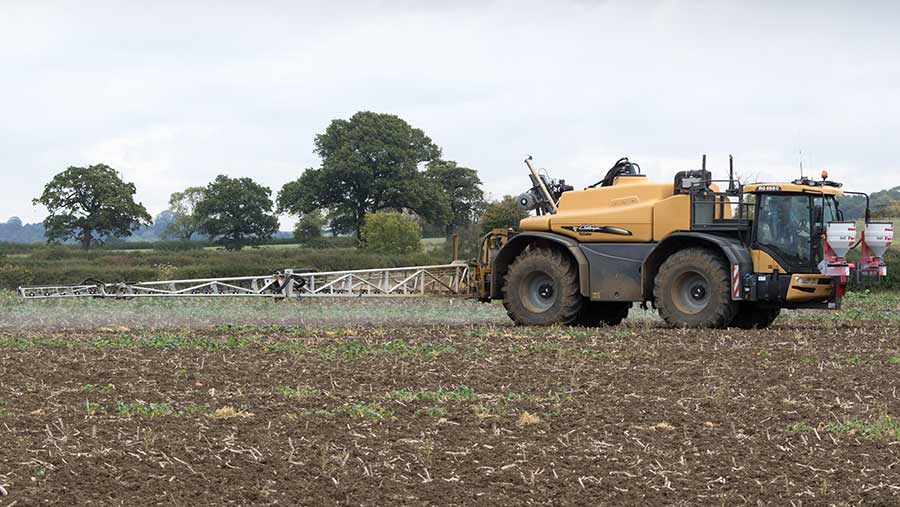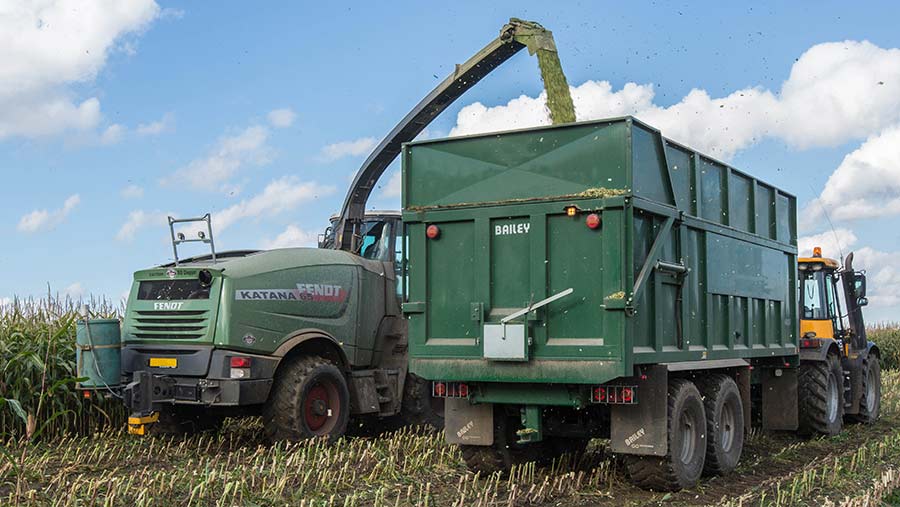Crop Watch: Give stale seed-beds more time for blackgrass kill
 © Tim Scrivener
© Tim Scrivener As we head further into October, pressure is rising on farmers to start drilling their wheat in bad blackgrass fields, especially if the neighbours have already made a start.
However, our agronomists are warning that the continuing dry conditions means the low-dormancy blackgrass seed is just waiting for rain to emerge.
The dry conditions also mean the pre- and peri-emergence herbicides are going to be less effective. So the risk of going now is that the only blackgrass control option will be wholecropping it early next summer.
See also: Variable drilling lifts wheat yield by 1t/ha in Hampshire
Our agronomists are also advising those farmers who have finished the maize harvest to plant a cover crop or cultivate in order to reduce the soil erosion risk this coming winter.

Iain Richards
South: Iain Richards
Agrii (Oxfordshire)
In September we needed a good 100mm of rain to get our oilseed rape away and bring on all that nice low-dormancy blackgrass well ahead of wheat drilling. But in most places, we got barely one-quarter of this.
This wouldn’t have been so much of a problem for our rapeseed if it hadn’t been for the worst flea beetle season we have ever had.
While we kept well on top of the little blighters with one or two sprays last autumn, it has taken a more determined effort this time round.
We have seen similar levels of damage with every establishment system and variety. Seed-bed fertiliser has made little difference either with conditions as dry as they’ve been.
Our split pre- and early post-emergence oilseed rape herbicide programme has been valuable in the dry conditions. We are planning to apply clethodim before the end of October in many cases to deal with substantial flushes of blackgrass.
Unfortunately, the dryness and less soil working means we have yet to see similarly strong stale seed-bed growth. However, after two months of good weathering, all the ground is nicely set up for rapid and effective drilling.
As a result, both wheat and barley have been going in particularly well so far on our low blackgrass risk ground, with the minimum of soil movement to preserve such moisture as there is.
Blackgrass risk
Wherever the risk is higher, though, we’re holding our nerve, as we know the blackgrass is there and at some stage we’ll get the rain we need to dispose of enough of it ahead of drilling.
What’s more, the ground is so dry it will take a lot of wetting before drilling is seriously compromised.
We also need more soil moisture because with the ground as dry as it is and soil temperatures and light levels as high as they continue to be, neither pre- nor peri-emergences would do much of a job.
So the blackgrass would grow right through them, leaving us with crop destruction as about our only control option.

Andy Goulding
North: Andy Goulding
CAS/Hutchinsons (Cheshire)
It feels like the busiest time we have had this cropping year, with the roads full again with farm machinery. This was partly due to the much-welcomed arrival of rain last month.
Grass has regrown and livestock farmers are extremely busy trying to fill half-full silage clamps. Maize harvest is also nearly complete.
Drilling cereals is well under way, with many finished early thanks to our limited grassweed problems. Those who do have problems, though, are having to exercise great patience as neighbours drill up around them.
Establishment is excellent so far, and with frequent enough showers, residual herbicides are in with a great chance of delivering the desired results.
It has been interesting to see even the most dedicated ploughman opting to lessen their cultivation depth and move away from inversion, as everything required for successful establishment has been on the surface. Anecic worms breathed a sigh of relief.
Aphid risk
All crops are relatively pest free apart from aphids, which can be found in crops. No one wishes to spray insecticides unless absolutely necessary, but protecting the crops is paramount and in those instances, I would suggest using the most ecologically friendly products.
To add further to the flurry of activity, storing potatoes is progressing well. Again, there are some positive outcomes in terms of yield and return to the grower, but with seasonal yields as low as 10t/ha and low contract prices, there has been many painful scenarios too.
Crop quality is generally good, though, with the odd bit of secondary growth here and there.
Maize harvest started early, with much of it cleared, and many crops are just waiting on contractor availability.
A lot of crops during the heatwave were tasseling early (at 0.9m tall), but some crops reached as tall as the chopper, which makes for much better viewing.
Good practice now would be to establish some green cover where possible, or at least break up the upper surface to minimise potential soil erosion.

Stephen Harrison
West: Stephen Harrison
AICC/Southwest Agronomy (Avon)
Early October and my first Crop Watch blog of the season. The only cereals emerged are on land relatively free from grassweeds, so there aren’t that many to watch.
Those crops that have been drilled are emerging rapidly from uniformly excellent seed-beds.
Winter barley looks to have excellent potential, with the scope for high tiller numbers.
I am always pleased to see a little bleaching from pre-emergence herbicides on the youngest crop leaves, as this means chemical is also being taken up by the weeds.
The main thrust of wheat drilling will start later this week. With a lot of variation in the thousand grain weight, there has been a lot of juggling with seed rates.
The AHDB barley yellow dwarf virus management tool looks to be a useful addition to the armoury and I will follow it with interest. Next year, with the absence of effective seed dressings, it will be even more relevant.
Maize harvest
Forage maize harvest is now complete, with only crops destined for crimping still to be cut. Yields have been variable, to say the least.
Maize now counts very much as an arable crop, with several farms growing it as an alternative break crop to sell to neighbouring dairy farms.
Oilseed rape paints a different picture. I have crops ranging from those wiped out by flea beetle to some now at four to six leaves needing growth regulation.
My concern for those poorer crops that managed to survive the worst of adult flea beetle attack is the presence of flea beetle larvae in the petioles, which does not bode well for winter survival of small crops.
We do seem to be free of myzus aphids in the West. So far levels of phoma leaf spotting are well below threshold. We will soon start submitting samples as part of the SpotCheck initiative to monitor light leaf spot levels.

© Tim Scrivener

Sean Sparling
East: Sean Sparling
AICC/SAS Agronomy (Lincolnshire)
The drought continues into autumn in Lincolnshire. In the five months since 1 May, I’ve registered 118mm of rain, compared with the same period last year, in which I measured 331mm.
Oilseed rape has thirstily struggled to outgrow wave after wave of cabbage stem flea beetle, following the most widespread and prolonged attack I’ve experienced this far north.
Growing conditions have done little to help battered plants withstand the damage and, in more cases than I’ve seen before, significant acreages have either been redrilled or written off altogether. Even perfectly timed pyrethroids have lacked reliability, but the timing has been everything.
Fields where OSR established quickly are the only ones that withstood the onslaught to any acceptable degree.
For the record, in the right conditions it doesn’t matter whether you spray for cabbage stem flea beetle by day or by night, with or without water conditioners, snake oils and expensive adjuvants.
That’s because if the beetles aren’t actually present or actively foraging at the time of application, you are wasting your time. Despite what some are saying, there is no residual activity.
Residual herbicides
Stale seed-beds are only just now seeing the first flush of blackgrass emerge – no surprise there – but there are many growers who have already lost their nerve and taken advantage of the dry conditions to go drilling. Only time will tell as to just how big a mistake that proves to be.
One thing is for certain – it may be dry, but if you drill into blackgrass fields, you must get those pre-emergence herbicides on within three days if possible. Don’t assume that, because it’s so dry, you either don’t need them or that they won’t work and should be delayed. Get them on ASAP.
If you drill it, spray it, because I have never once regretted the decision to apply pre-emergence herbicides in dry conditions. I have, however, on more than one occasion regretted the decision made by some growers not to apply them.
It’s a game of chicken, hold your nerve on those blackgrass fields and leave that drill alone.

